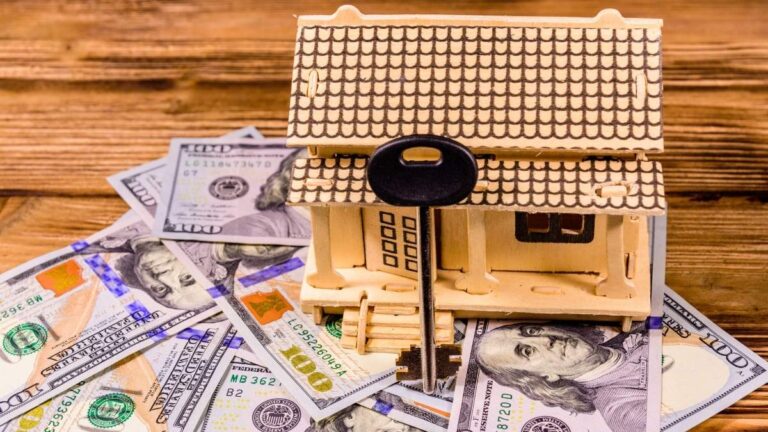How to Buy a Foreclosed Home: 6-Step Guide and Tips

If you scan real estate websites, you’ve likely noticed homes listed as foreclosures or bank-owned properties. Some of the prices might look good, but buying and financing a foreclosed home isn’t a cakewalk.
Here are some things to know about buying foreclosed homes.
What Does ‘Foreclosure’ Mean?
A foreclosure is a home a lender or lienholder has taken from a borrower who has not made payments for a period of time. The lender or lienholder hopes to sell the property for close to what is owed on the mortgage.
Who can place a lien on a home? A mortgage lender, the IRS, or the U.S. Department of Housing and Urban Development (for nonpayment of an FHA loan, resulting in HUD homes for sale).
A county (for nonpayment of property taxes), an HOA, or a contractor also can.
How Does the Foreclosure Process Work?
Foreclosure processes differ by state. The main difference is whether the state generally uses a judicial or nonjudicial foreclosure process. A judicial foreclosure may require an order from a judge.
Once a borrower has missed three to six months of payment, depending on state law, the lender will post a public notice, sometimes known as a notice of default or “lis pendens,” which means pending suit.
A borrower then has 30 to 120 days to attempt to avoid foreclosure. During pre-foreclosure, a homeowner may apply for a loan modification, ask for a deed in lieu of foreclosure, pay the amount owed, or attempt a short sale.
A short sale is when the borrower sells the property and the net proceeds are short of the amount owed on the mortgage. A short sale needs to be approved by the lender.
If none of the options work, the lender might sell the foreclosed property at auction — a trustee or sheriff’s sale. Notice of the auction must be given at the county recorder and in the newspaper.
If no one buys the home at auction, it becomes a bank or real estate-owned (REO) property. These properties are sold in the traditional real estate market or in bulk to investors at liquidation auctions.
In some states under the judicial foreclosure process, borrowers may have the right to redeem their property after the sale by paying the foreclosure sale price or the full amount owed to the lender, plus other allowable charges.
How to Buy a Foreclosed Home
Step 1: Know the Options
Buying foreclosed homes at an auction or through a lender are the prime ways to purchase these homes. Keep in mind that a foreclosure is usually an “as-is” deal.
Buying at Auction: In almost all cases, bidders in a live foreclosure auction must register and show that they have sufficient funds to pay for the property in full.
Online auctions have gained popularity. You can sign up with a site to find foreclosure auctions in an area where you want to buy, or research foreclosure sales data by county online, at the county courthouse, or from the trustee (the third-party foreclosure sales agent).
It’s important to look into how much the borrower owes and whether there are any liens against the property. The winning bidder may have to pay off liens. It’s smart to hire a title company or real estate attorney to provide title reports on properties you’re interested in bidding on.
Buying From the Lender: You can find listings on websites that aggregate REO properties or on a multiple listing service. When checking out the homes you like, take note of the real estate agent’s name. Banks usually outsource the job of selling foreclosed homes to REO agents, who work with standard real estate agents to find a buyer.
REO listings are often priced at or below market value. Also good to know: The lender usually clears the title and evicts the occupants before anyone buys a foreclosed home.
Looking at Opportunities Before Foreclosure: If the lender allows a short sale, potential buyers work with the borrower’s real estate agent and the lender to find a suitable price.
With pre-foreclosures, when borrowers have missed three or more mortgage payments but still own the home, the lender might work with them to avoid foreclosure, or the homeowner might entertain purchase offers, whether the home is listed or not.
Step 2: Hire a Real Estate Agent
It’s a good idea not to go with just any agent, even if you like them and have used their services for a standard home purchase, but to find an agent who specializes in foreclosure sales.
That agent can help you search for a home, negotiate a price, and order an inspection. Your offers might be countered.
Step 3: Find Foreclosures for Sale
In addition to checking with local real estate companies for foreclosed homes, there are paid and free sites to search.
Among the free:
- Equator.com
- HomePath.com
- HomeSteps.com
- Realtor.com
- reo.wellsfargo.com
- foreclosures.bankofamerica.com
- treasury.gov/auctions/irs
- resales.usda.gov/resales
- hudhomestore.gov
- vrmproperties.com
Paid sites include foreclosure.com and RealtyTrac.
Step 4: Get Pre-approved for a Mortgage
If you want to act fast on buying a foreclosed home, you’ll want to get pre-approved for a mortgage. Pre-approval tells you how much money you are eligible to borrow and lays out the terms of final approval on a mortgage in a pre-approval letter.
Pre-approval may help you compete with the all-cash buyers who like to purchase foreclosures.
Step 5: Get an Appraisal and Inspection
Buyers of REO properties would be smart to order a home inspection.
A thorough checkup can document flaws and help them tally home repair costs.
An REO property appraisal usually consists of an as-repaired valuation — the market value if the property is repaired, compared with comps — and an as-is valuation. Some lenders also ask for a quick-sale value and a fair market value.
You can challenge the results of an appraisal if you think the figures are off, and you can hire another appraiser for an independent assessment.
Step 6: Purchase Your New Home
If you decide to move forward, contact your mortgage lender to finalize your loan. Submit your offer with the help of your real estate agent. If your offer is accepted, you will sign a contract and transfer ownership. You may be required to pay an earnest money deposit.
The certificate of title may take days to complete. During that time, the original borrower may be able to file an objection to the sale and pay the amount owed to retain their rights to the property. So it’s a good idea to do no work on the property until you receive the certificate of title.
Benefits of Buying a Foreclosed Home
Buying a foreclosed home can be a great deal for a buyer who sees the potential, is either handy or budgets realistically for repairs, and knows the fixed-up value.
Many but not all properties are in poor shape. If a homeowner dies or has a reverse mortgage that ends, a home that was maintained may be returned to the lender.
REO properties rarely have title discrepancies. The repossessing lender has extinguished any liens against the property and ensured that taxes were paid.
It’s possible to negotiate when buying REO properties. You could ask the lender to pay for a termite inspection and the appraisal, or even all the upgrades needed to bring the property up to code.
Drawbacks of Buying a Foreclosed Home
Buying a foreclosed home can be complicated. The process is governed by state and federal laws.
Because many REO properties have sat vacant and most are sold as-is, financing can be a challenge.
- Fannie Mae dictates that for a conventional conforming loan, the home must be “safe, sound, and structurally secure.”
- For an FHA, VA, or USDA loan, the home must be owner occupied and in livable condition, with a functional roof, foundation, and plumbing, electrical, and HVAC systems, and no peeling paint.
- A standard FHA 203(k) loan includes the purchase of a primary house and substantial repairs costing up to the county loan limit. But relatively few lenders offer these loans, the application process is more intensive, and contractors must submit bids and complete paperwork. Mortgage rates are somewhat higher than for standard FHA loans.
Many people, especially first-time home buyers, think foreclosures are offered at a deep discount, but even low-priced homes might get multiple offers above the asking price from buyers eager to snap up a fixer-upper.
The Takeaway
Buying a foreclosed home requires vision, risk tolerance, and realistic number crunching. If you need financing, it’s a good idea to get pre-approved for a mortgage so that all your ducks are in a row when you spot a potential deal.
3 Home Loan Tips
- Traditionally, mortgage lenders like to see a 20% down payment. But some lenders, such as SoFi, allow mortgage loans with as little as 3% down for qualifying first-time homebuyers.
- Not to be confused with pre-qualification, pre-approval involves a longer application, documentation, and hard credit pulls. Ideally, you want to keep your applications for pre-approval to within the same 14- to 45-day period, since many hard credit pulls outside the given time period can adversely affect your credit score, which in turn affects the mortgage terms you’ll be offered.
- Generally, the lower your debt-to-income ratio, the better loan terms you’ll be offered. One way to improve your ratio is to increase your income (hello, side hustle!). Another way is to consolidate your debt and lower your monthly debt payments.
Disclaimer:
SoFi Mortgages
Terms, conditions, and state restrictions apply. Not all products are available in all states. See SoFi.com/eligibility for more information.
SoFi Loan Products
SoFi loans are originated by SoFi Bank, N.A., NMLS #696891 Opens A New Window.(Member FDIC), and by SoFi Lending Corp. NMLS #1121636 Opens A New Window., a lender licensed by the Department of Financial Protection and Innovation under the California Financing Law (License # 6054612) and by other states. For additional product-specific legal and licensing information, see SoFi.com/legal. Equal Housing Lender.
Financial Tips & Strategies: The tips provided on this website are of a general nature and do not take into account your specific objectives, financial situation, and needs. You should always consider their appropriateness given your own circumstances.
SOHL0422001
This article is originally on SoFi.






